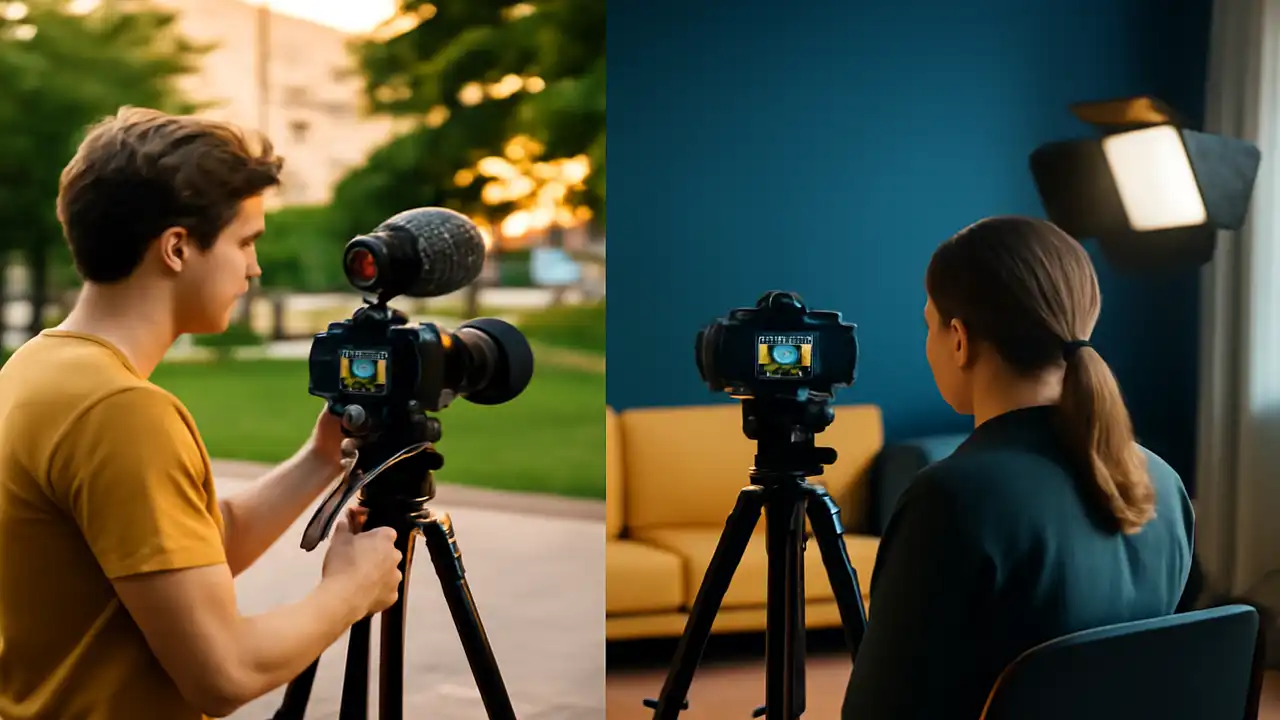Explore expert tips for handling lighting and noise challenges when filming outdoors vs indoors. Learn practical techniques to optimize your video quality for professional results and better SEO performance.
Filming Outdoors vs Indoors: Dealing with Lighting and Noise Challenges Introduction

Introduction
In the world of filmmaking, choosing between filming outdoors or indoors plays a critical role in the overall production quality. Lighting and noise challenges are among the most significant factors that filmmakers must address to create visually appealing and clear videos. Understanding how to manage these challenges effectively can elevate your production from amateur to professional. This article explores the nuances of filming outdoors vs indoors, focusing on how to handle lighting and noise issues, making it a must-read for videographers, content creators, and filmmakers aiming for high-quality results.
Keywords: filming outdoors vs indoors, lighting challenges in filming, noise control in video production, outdoor filming tips, indoor filming techniques, managing noise on set
Detailed Explanation: Understanding the Challenges of Filming Outdoors vs Indoors Lighting Challenges
Outdoor Filming:
Filming outdoors offers natural light, which is often the most flattering and dynamic source for video production. However, natural light is unpredictable and constantly changing due to weather, time of day, and geographical location. Direct sunlight can cause harsh shadows, overexposure, and fluctuating brightness levels that are difficult to control. Conversely, overcast days can create flat lighting that lacks depth.
Indoor Filming:
Indoors, filmmakers have more control over lighting conditions by using artificial lights such as LED panels, softboxes, and reflectors. However, achieving natural-looking lighting indoors requires skillful placement and balancing of lights to avoid unwanted shadows, glare, or unnatural color tones.
Noise Challenges
Outdoor Filming:
Ambient noise is a major challenge when filming outside. Sounds like wind, traffic, animals, or crowds can interfere with audio clarity, requiring additional equipment or post-production editing to reduce unwanted noise. Wind noise, in particular, can ruin audio recordings unless windshields or specialized microphones are used.
Indoor Filming:
Indoors, noise control is generally easier but not guaranteed. HVAC systems, echoes from hard surfaces, or outside noise leaking through walls can affect sound quality. Proper acoustic treatment and strategic microphone placement are necessary to minimize indoor noise.
Practical Tips and Techniques for Managing Lighting and Noise
- For Outdoor Filming:
- Use reflectors and diffusers to soften harsh sunlight and fill shadows.
- Schedule shoots during the golden hours (early morning or late afternoon) for natural, soft lighting.
- Utilize ND filters on cameras to manage brightness without changing aperture or shutter speed.
- For Indoor Filming:
- Set up three-point lighting (key light, fill light, back light) for balanced and professional-looking illumination.
- Use softboxes or diffused lighting to avoid harsh shadows.
- Adjust color temperature of lights to match the desired mood or daylight balance.
Noise Control Tips
- For Outdoor Filming:
- Use directional microphones or shotgun mics to focus on desired sounds and reduce background noise.
- Employ windshields or dead cats on microphones to reduce wind noise.
- Consider recording ambient sounds separately for post-production mixing.
- For Indoor Filming:
- Use sound blankets or foam panels to dampen echoes.
- Turn off noisy appliances and close windows to limit external sounds.
- Position microphones close to the sound source for clearer audio capture.
Linking to Resources
For more in-depth techniques on lighting setups, check out our article on Professional Lighting Techniques for Video Production. Additionally, to learn about audio equipment suitable for noisy environments, visit Top Microphones for Clear Audio Recording.
For authoritative external resources, the American Society of Cinematographers provides extensive guides on lighting and sound design in film.
SEO Optimization and Content Best Practices
To ensure your content is optimized for search engines:
- Incorporate primary keywords like "filming outdoors vs indoors" naturally throughout the article.
- Use long-tail keywords such as "how to manage lighting during outdoor filming" or "noise reduction techniques for indoor videos" to attract targeted traffic.
- Include meta description that summarizes the article with keywords. For example:
"Explore essential lighting and noise challenges when filming outdoors vs indoors, with expert tips to optimize your video production quality." - Use alt text on all images describing the scene with keywords, e.g., "Outdoor filming setup showing natural light usage" or "Indoor video shoot with professional lighting."
Image Optimization Tips
- Select high-quality, relevant images demonstrating outdoor and indoor filming setups.
- Compress images to reduce page load time, enhancing user experience and SEO rankings.
- Always add descriptive alt text that includes relevant keywords to improve image search visibility.
Conclusion and Call to Action
Filming outdoors and indoors both come with unique lighting and noise challenges that require different approaches and equipment. By understanding these challenges and applying practical techniques, filmmakers can enhance the quality of their productions significantly. Whether you’re a beginner or an experienced videographer, mastering these skills will set your work apart.
If you found this guide helpful, please share it with fellow creators !
Continuous Improvement and Analysis
Regularly update your article with new tips and emerging technologies in lighting and sound control to keep content fresh and authoritative. Use analytics to track keyword rankings, user engagement, and update content based on search trends and reader feedback.